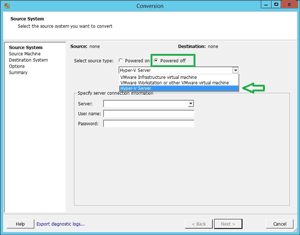3 Cool New Features of vCenter Converter
It's been around a long time, but it's far from dead.
- By Rick Vanover
- 08/18/2016
Even though I don't use VMware vCenter Converter often, it's good to know that the product is still innovating. The main thing to note is that for more than a year it's been vSphere-6 ready and supports working with virtual machine hardware version 11. (Speaking of hardware versions, this VMware KB is a handy to guide to ESX/ESXi versions and their hardware compatibility.)
Back to VMware vCenter Converter (I'll just call it Converter, as that's what we all call it): there are still good use cases for it. For instance, a primitive archive of a desktop or laptop; migration from other hypervisors; and P2V are still ways that Converter can come to the rescue. Since I've given Converter a look, 6.0 (Release notes) and 6.1 (Release notes) have been released. I found a few interesting new features in those updates that are worth sharing.
1. Operating systems have been brought current. In 2014, I wrote that I was surprised that Windows Server 2012 was supported, but not the R2 edition. Since 6.0 in May 2015, Windows Server 2012 R2 as well as a number of other operating systems have been supported, including Windows 8.1, Windows 10, CentOS 6-8, Ubuntu 14 and 15 and RHEL 7.
At the same time, older operating systems have been removed. You can't install on or convert Windows XP any more, for example. Vista SP2, according to the release notes, can still have Converter installed, as well for any edge cases.
2. Offline conversion of Hyper-V 2012 R2 virtual machines is now supported. This is an interesting one, which came in Converter 6.1. I'm not arguing that a conversion is a good idea, but it's nice to have an offline option. This is especially important if you were to do one of the things you're not supposed to do, like convert a domain controller (DC). But if you were to move a VM running a DC, this becomes a way to move it offline to eliminate contention when it comes back online. Note that a service is installed on the host (and can be removed later). This step is shown in Figure 1.
 [Click on image for larger view.]
Figure 1. Hyper-V hosts can be read for an offline conversion with vCenter Converter.
[Click on image for larger view.]
Figure 1. Hyper-V hosts can be read for an offline conversion with vCenter Converter.
3. Backup images as source are no more. I've never used this feature, but Converter 6.0 was the last release in which it was supported. The use case here was an unplanned restore to a VM in event of a backup and series of failures. This can be done a few other ways now, and the original use case -- large-scale migrations via the backups -- doesn't make sense anymore. Nonetheless, it's worthwhile to note this drop of functionality.
There are still plenty of use cases for Converter. As it relates to the specific operating system support, it's a good idea to read the release notes in depth. This is especially important if you have older operating systems as VMs, such as Windows Server 2003 R2 (which isn't supported by 6.1 of Converter). On the plus side are newer features like Converter's ability to fully operate over IPv6.
I've used Converter for about 10 years, on and off. In those 10 years, the way I've used it has changed, and I know a lot of people who hold on to old versions of Converter (and ESXi, VMware Tools and other favorites) to handle situations involving obsolete operating systems.
Remember that the infrastructure can't do it all. This means there will be a time when the older operating systems that are effectively preserved forever as a VM will become a problem. Anything you can do now to upgrade obsolete applications and operating systems will help you in the future. Do you still use Converter? If so, how? Share your comments below.
About the Author
Rick Vanover (Cisco Champion, Microsoft MVP, VMware vExpert) is based in Columbus, Ohio. Vanover's experience includes systems administration and IT management, with virtualization, cloud and storage technologies being the central theme of his career recently. Follow him on Twitter @RickVanover.